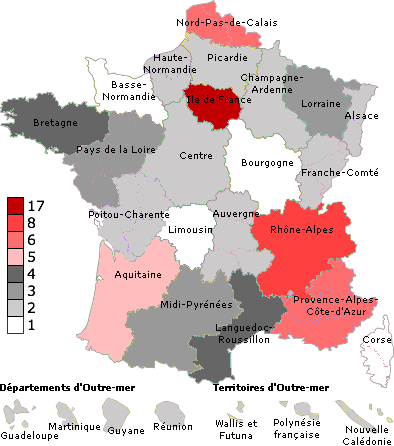It is a famous, even infamous fact about French universities that the system is deeply centralized, and centered on Paris. But over the years the university system has diversified and there are now 83 French public universities (of which 5 are in Corsica and the overseas territories). However, as every French academic would surely attest, the system remains deeply Paris-centric. For the foreign reader, I thought it would be helpful to present a little map of the density of universities by region (based on this original):
The scale refers to the number of universities in a given region. A few regions, shown in white, have only one university each; the majority of regions, colored grey, have two or three or four; and then there are a handful of regions with five or more, shown in various shades of red. Paris (or rather Ile-de-France, which simply means the Parisian metro area) is the major outlier, with 17 universities. Alas, I couldn’t find a color bright enough to indicate this degree of institutional dominance, and this isn’t even taking into account all the other major academic institutions that are primarily based in Paris: the Collège de France, the École Normale Supérieure, Sciences Po, EHESS, and so on. As for the universities outside France proper, there is one in Corsica (Corse) and two each in the Territoires and the Départements d’Outre-mer. (I actually know nothing whatsoever about these overseas universities; it would be interesting to learn about them.)
Looking at the diagram, it’s striking how Paris is surrounded by relatively empty academic space. The other big university poles would seem, in fact, to be as far from Paris as possible, at the southwest or southeast or far northern corners of the country. As if outside Paris there was an academic void for a while and major university centers only sprang up again when they could begin to escape its presence. The smaller red regions are far from the capital city.
All the same, I should acknowledge that this is probably a moderately misleading map. It doesn’t show number of students or number of teachers or institutional prestige, and these don’t always vary directly with the mere number of universities. In fact, it seems that when a city has multiple universities, they often began as one institution and were organizationally separated at some point. The University of Paris, after all, began as one entity and now there are 13 of it; 13 separate Universities of Paris, I mean. So sheer number of universities in a territory is not itself a conclusive measure of much.
But I do think if we mapped out student populations on the same map we’d find a roughly similar distribution, and this map does help visualize the Parisian center—provincial periphery system that continues to organize academic space in France. Nothing like it exists in the United States, where the most prestigious universities tend to be somewhat spaced out and located in different cities (they once primarily served students from their own regions, I suppose); of course there are major university cities like Boston and New York, but no single center is dominant.
That said, even within Paris there is enormous intellectual stratification, amounting to a center within a center. The oldest and fanciest institutions are clustered in the Latin Quarter right in the center of town not far from the centers of French government, as if spatial proximity to the French State went hand in hand with intellectual dominance in the academic world, while the universities of the outskirts (banlieues) are often poorer, serving more working-class students in poorer conditions, as in Paris-8 in Saint-Denis where I’m working this year. If you wanted to say something abstract about this, you might observe that it’s curious how national space symbolically structured according to these sorts of status differentials, which moreover form a sort of fractal where every center has its own internal periphery and every periphery appears to have its local center. Within Paris there is another periphery; and then again even within the center of the Parisian center we can still find marginal zones; and yet still within the periphery of the Parisian center, as at Paris-8, there are still smaller zones of dominance and zones of social abandonment. I was just hearing about Alexandre Bikbov’s research where he asked people to draw maps of how they see their social world: and it crosses my mind suddenly as I’m writing that it would be tremendously interesting to ask people to draw me maps of the French university world as they picture it.
